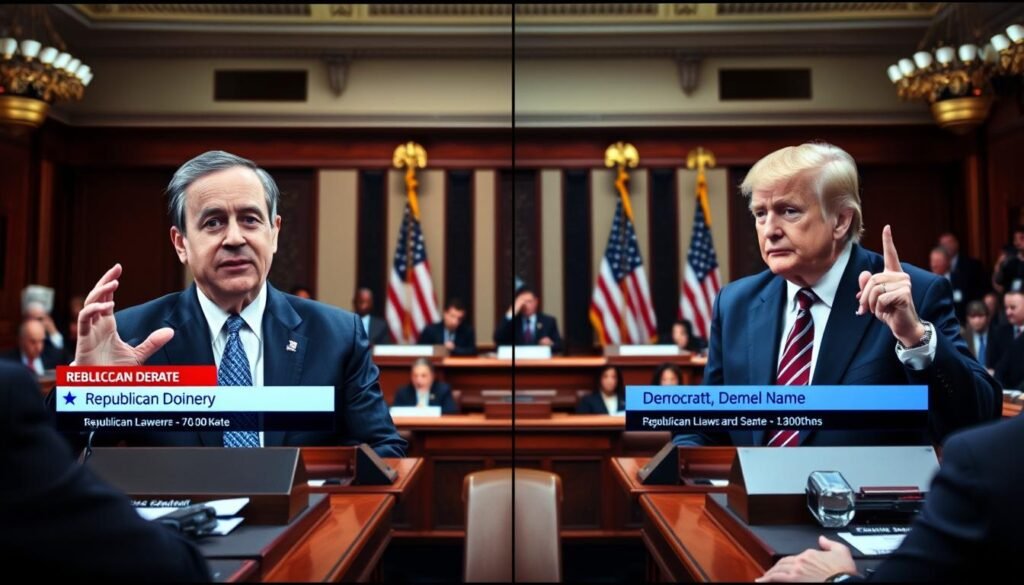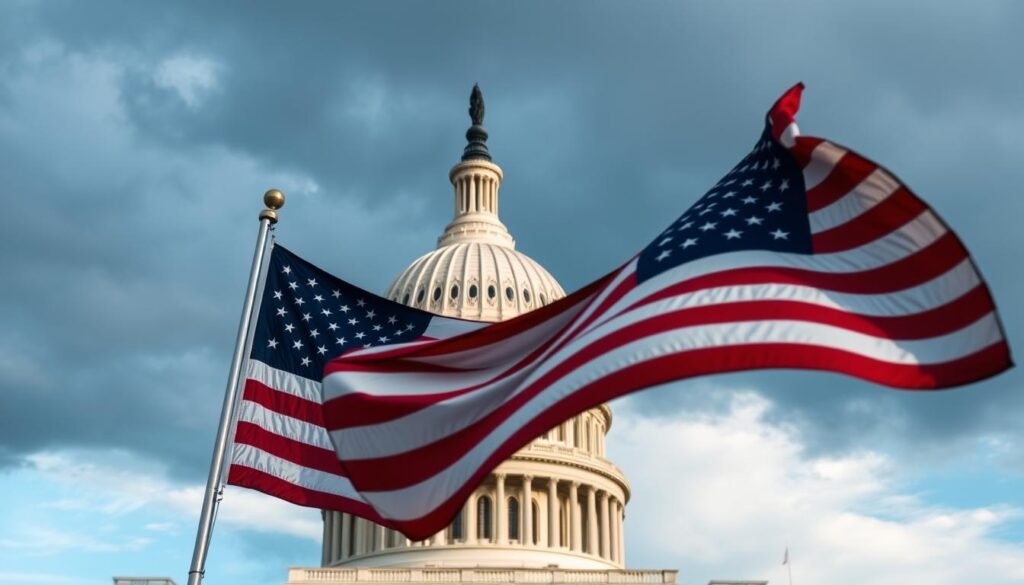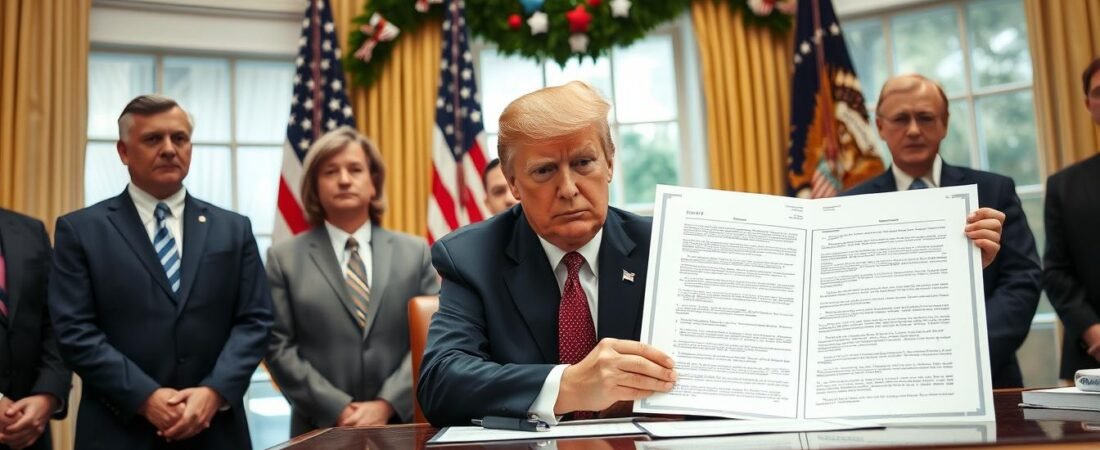The “One Big Beautiful Bill Act” represents one of the most significant legislative packages in recent American history. Passed by House Republicans and signed into law, this sweeping legislation combines tax cuts with substantial changes to healthcare programs, immigration enforcement, and federal spending priorities. As Americans grapple with its implications, a crucial question emerges: will the bill’s short-term economic benefits outweigh potential long-term fiscal and social costs?
This comprehensive analysis examines the bill’s key provisions, explores diverse perspectives from across the political spectrum, and evaluates potential impacts on different segments of American society. By understanding both the opportunities and challenges presented by this legislation, citizens can better navigate its effects on their lives and communities.
President Trump signs the One Big Beautiful Bill Act during a Fourth of July celebration at the White House
Key Provisions of the Big Beautiful Bill
The One Big Beautiful Bill Act contains numerous provisions that will significantly reshape federal programs and spending priorities. Understanding these changes is essential for evaluating the legislation’s potential impacts on different segments of American society.
Healthcare Changes
The bill includes significant modifications to healthcare programs that millions of Americans rely on. According to the Congressional Budget Office, these changes could increase the number of uninsured Americans by approximately 10 million while reducing federal Medicaid spending by nearly $800 billion.
Key healthcare provisions include:
- Implementation of work requirements for Medicaid recipients
- Reduction of federal Medicaid match rates for states that expanded coverage to certain immigrant populations
- Elimination of funding for Planned Parenthood and similar clinics that provide abortion services
- Shortened enrollment windows and increased paperwork requirements for ACA marketplace insurance
- Changes to Medicare Savings Programs that help low-income seniors afford healthcare
Tax Provisions
The legislation makes permanent many of the tax cuts implemented during Trump’s first term while adding new tax benefits. The Congressional Budget Office estimates these changes will add approximately $3.4 trillion to the federal deficit over the next decade.
Notable tax provisions include:
- Permanent extension of individual and corporate tax cuts from the 2017 Tax Cuts and Jobs Act
- Increased tax-free income allowance for venture capital investors (from $10 million to $15 million)
- 100% tax credit for donations to private school voucher funds
- Elimination of tax credits for clean energy production
Immigration and Border Security
The bill allocates nearly $30 billion to expand immigration enforcement operations, tripling the annual budget of U.S. Immigration and Customs Enforcement (ICE). This represents one of the largest increases in immigration enforcement funding in U.S. history.
Other Significant Provisions
- Reduction in funding for food assistance programs, including changes to SNAP (Supplemental Nutrition Assistance Program)
- Creation of a $100 million fund for the Office of Management and Budget to identify “budget and accounting efficiencies”
- Changes to student loan repayment plans that could increase monthly payments for borrowers
Diverse Perspectives on the Big Beautiful Bill
The One Big Beautiful Bill Act has generated strong reactions across the political spectrum. Understanding these diverse viewpoints helps provide a more complete picture of the legislation’s potential impacts.
Republican Perspectives
Many Republicans and supporters of the Make America Great Again (MAGA) movement view the bill favorably, with approximately 60% of Republicans expressing support. This backing is particularly strong among MAGA supporters, with 72% viewing the legislation positively.
Republican supporters emphasize the bill’s potential to stimulate economic growth through tax cuts and reduce what they see as wasteful government spending. They argue that Medicaid reforms will primarily eliminate fraud and waste rather than reduce necessary coverage.
“Today we are laying a key cornerstone of America’s new golden age,” said House Speaker Mike Johnson during floor debate on the legislation. “This bill will make the U.S. stronger, safer and more prosperous than ever before.”
However, support is not universal among Republicans. Approximately two-thirds of Republicans who don’t identify with the MAGA movement view the bill unfavorably, indicating significant divisions within the party.
Democratic Perspectives
Democrats have been overwhelmingly critical of the legislation, with 85% expressing unfavorable views. Democratic lawmakers have particularly focused on the bill’s healthcare provisions, arguing they will increase costs and reduce access for vulnerable populations.
“Everybody should vote no against it because of how it attacks children and seniors and everyday Americans. And people with disabilities. That is why I stand here on the floor of the House of Representative with my colleagues in the House Democratic caucus to stand up and push back against it with everything we have.”
Democrats have characterized the bill as prioritizing tax cuts for wealthy Americans while reducing support for working-class families. They point to Congressional Budget Office estimates that the legislation will increase the deficit by $3.4 trillion over the next decade.

Contrasting reactions from Republican and Democratic lawmakers during debate on the Big Beautiful Bill
Public Opinion
According to KFF Health Tracking Poll data, nearly two-thirds of the public (64%) hold an unfavorable opinion of the tax and budget bill, while one-third (35%) view it favorably. These opinions are strongly influenced by political affiliation, with support highest among MAGA supporters and opposition strongest among Democrats and independents.
Public support for the bill decreases significantly when people learn about specific provisions. For example:
- Support drops 14 percentage points (to 21%) after hearing the legislation would decrease funding for local hospitals
- Three-fourths of the public (74%) view the legislation unfavorably after learning it would increase the number of uninsured Americans by approximately 10 million
- Even among Republicans and MAGA supporters, majority support turns to majority opposition when informed about hospital funding cuts and increased uninsured rates
Download Our Comprehensive Analysis
Get our detailed 35-page report on the Big Beautiful Bill’s economic projections, healthcare impacts, and state-by-state effects.
Healthcare Impacts of the Big Beautiful Bill
The healthcare provisions in the One Big Beautiful Bill Act represent some of the most significant and controversial aspects of the legislation. These changes will affect millions of Americans who rely on Medicaid, Medicare, and ACA marketplace insurance.

Healthcare professionals discussing potential impacts of policy changes on patient care
Medicaid Work Requirements
One of the bill’s central healthcare provisions requires nearly all adults with Medicaid coverage to prove they are working, looking for work, in school, or doing community service, with exceptions for caregivers and people with disabilities. While 68% of Americans initially support this concept, support drops significantly when additional context is provided.
For example, when informed that most Medicaid recipients are already working and many could lose coverage due to paperwork difficulties, support for work requirements falls from 68% to 35%. Similarly, when told that work requirements would not significantly impact employment but would increase state administrative costs, support drops to 40%.
Key Fact: Most working-age adults on Medicaid are already employed or have caregiving responsibilities or disabilities that prevent them from working. However, 56% of Americans incorrectly believe most Medicaid recipients are unemployed.
For current Medicaid recipients, the potential loss of coverage could have severe consequences:
- 68% say it would be “very difficult” to afford prescription medications without Medicaid
- 59% would struggle to afford seeing healthcare providers
- 56% would find it “very difficult” to obtain and pay for alternative insurance
- 75% believe losing coverage would have a “major impact” on their financial well-being
- 69% say it would significantly affect their overall quality of life
Changes to Planned Parenthood Funding
The bill includes a provision to stop all federal healthcare payments to Planned Parenthood and similar clinics for services like birth control and health screenings provided to Medicaid recipients if the clinics also offer abortion services. About two-thirds of Americans (67%) oppose this provision, while one-third (32%) support it.
Opposition is strongest among Democrats (89%) and independents (70%), while Republicans are more divided (54% support, 46% oppose). Among MAGA supporters, more than 60% favor stopping payments to these clinics.
As with work requirements, opinions shift when additional information is provided. Support for defunding drops from 32% to 19% when people learn that cutting Medicaid payments would make it difficult for lower-income women to access non-abortion health services like STI treatment, cancer screenings, and birth control.
ACA Marketplace Changes
The legislation includes provisions to shorten enrollment windows and increase eligibility paperwork requirements for adults who purchase health insurance through the ACA marketplaces. About one-third of Americans (34%) support these changes, while two-thirds (65%) oppose them.
Opposition crosses party lines, with most Democrats (79%) and independents (68%) against these provisions, along with nearly half of Republicans (47%). Only among MAGA supporters does a majority (55%) favor these changes.
Economic Impacts and Fiscal Considerations
The One Big Beautiful Bill Act includes significant tax cuts and spending changes that will have far-reaching economic implications. The Congressional Budget Office estimates the legislation will increase the federal deficit by approximately $3.4 trillion over the next decade.
Tax Provisions and Their Distribution
The bill’s tax provisions have been criticized for disproportionately benefiting higher-income Americans. According to analysis cited in the SERP results, the legislation will increase the cost of living and lower after-tax income for the bottom 40% of earners while giving the top 20% of earners an average tax cut of $6,000 per year.
Specific provisions that have drawn scrutiny include:
- The “qualified small business stock exclusion” that allows wealthy venture capitalists to claim $15 million in income tax-free (up from $10 million) for investing in certain startup companies
- A federal 100% tax credit for individuals who donate to private school voucher funds, which could cost the federal government nearly $51 billion annually
Potential Economic Benefits
- Tax cuts could stimulate business investment and economic growth
- Reduced regulations may decrease compliance costs for businesses
- Increased border security funding could create new jobs in that sector
- Private school voucher tax credits could expand educational options
Potential Economic Concerns
- $3.4 trillion increase in federal deficit over 10 years
- Reduced healthcare coverage could increase uncompensated care costs
- Disproportionate benefits for higher-income Americans
- Potential reduction in consumer spending as safety net programs are cut
- Decreased funding for public schools in rural and underserved areas
Impact on States and Local Communities
The legislation will affect states and local communities differently based on their current policies and demographics. Some provisions that could have significant local impacts include:
- Penalties for states that have used their own funds to expand healthcare coverage to immigrants
- Restrictions on states’ ability to use provider taxes to fund Medicaid, which could particularly harm rural hospitals
- Diversion of public school funding through private school voucher tax credits, with potentially greater impacts on rural communities with few private school options
The bill also creates unusual incentives regarding state administration of SNAP benefits. States with the highest error rates in benefit distribution (including Alaska, Florida, Georgia, and several others) would be temporarily exempted from a provision shifting SNAP costs from the federal government to state governments. This could paradoxically reward poor program administration while penalizing states with moderate error rates.
State-Specific Examples and Impacts
The One Big Beautiful Bill Act will affect different states in various ways based on their current policies, demographics, and economic conditions. Understanding these state-specific impacts provides a more concrete picture of how the legislation will influence communities across America.
Rural Communities and Hospital Funding
The bill’s restrictions on state provider taxes could significantly impact rural hospitals, which often operate on thin margins and rely heavily on Medicaid funding. Several Republican senators expressed concerns about this provision due to its potential effect on healthcare access in rural areas.
Additionally, the private school voucher tax credit could disproportionately harm rural communities, which typically have few or no private school options. When voucher programs lead to state funding cuts for public education, rural schools are often hit hardest due to their heavy reliance on state and federal funds.
States with Expanded Medicaid Coverage
States that expanded Medicaid coverage under the Affordable Care Act will face particular challenges under the new legislation. The bill penalizes states that have used their own funds to provide coverage to immigrant populations by reducing federal match rates for their Medicaid expansion groups.
This provision could create difficult choices for states that have prioritized broader healthcare access, potentially forcing them to either accept reduced federal funding or scale back coverage for vulnerable populations.
Frequently Asked Questions About the Big Beautiful Bill
How will the Big Beautiful Bill affect the average American family?
The impact will vary significantly based on income level, healthcare needs, and use of federal programs. According to polling data, 44% of Americans believe the bill will hurt them and their families, while 32% of Republicans think it will help them. Families who rely on Medicaid, SNAP benefits, or ACA marketplace insurance may face increased costs or reduced access to services. Higher-income families may benefit from tax cuts, with the top 20% of earners receiving an average tax cut of ,000 per year.
Will the Big Beautiful Bill increase or decrease the federal deficit?
According to the Congressional Budget Office, the bill will increase the federal deficit by approximately .4 trillion over the next decade. This is primarily due to tax cuts and increased spending on border security and immigration enforcement, which outweigh reductions in healthcare and food assistance programs.
How many people could lose health insurance under this legislation?
The Congressional Budget Office estimates that approximately 10-12 million Americans could lose health insurance coverage as a result of the bill’s changes to Medicaid and the ACA marketplaces. This includes people affected by work requirements, increased paperwork burdens, and reduced enrollment opportunities.
What happens to Planned Parenthood funding under this bill?
The bill stops all federal healthcare payments to Planned Parenthood and similar clinics for services provided to Medicaid recipients if those clinics also offer abortion services. This would affect services like STI screening, cancer screenings, and contraception. The Hyde Amendment already prohibits federal funds from being used for abortion services, but this provision goes further by blocking funding for all services at these facilities.
How will the bill affect student loan repayment?
The legislation eliminates existing student loan repayment plans and offers future borrowers only two options: a standard plan and the Repayment Assistance Plan (RAP). Analysis suggests that a typical borrower with a college degree would pay an additional ,929 per year in student loan payments under RAP compared to current options like the SAVE plan.
Stay Informed as Implementation Unfolds
The Big Beautiful Bill’s impacts will become clearer as implementation begins. Subscribe to receive monthly updates, expert analysis, and resources to help you navigate these changes.
Conclusion: Balancing Short-Term Gains and Long-Term Costs

The debate over the Big Beautiful Bill reflects broader questions about America’s priorities and future
The One Big Beautiful Bill Act represents a significant shift in federal priorities, with substantial implications for healthcare access, tax policy, and social safety net programs. As implementation begins, Americans will experience its effects differently based on their income levels, healthcare needs, and reliance on federal programs.
Public opinion on the legislation remains deeply divided along partisan lines, though support decreases across the political spectrum when people learn about specific provisions related to healthcare access and hospital funding. This suggests that the bill’s long-term political viability may depend on how its implementation affects everyday Americans.
As the country moves forward under this new legislative framework, the central question remains: Will the promised economic benefits materialize and outweigh potential costs to vulnerable populations and long-term fiscal stability? The answer will unfold in the coming years as Americans experience the real-world impacts of these policy changes in their communities and daily lives.

Social Impacts and Vulnerable Populations
Beyond economic considerations, the One Big Beautiful Bill Act will have significant social impacts, particularly for vulnerable populations who rely on federal programs for basic needs.
Many families are concerned about how changes to federal programs will affect their access to healthcare and food assistance
Food Assistance Changes
The bill reverses bipartisan SNAP paperwork-requirement exemptions for vulnerable groups including veterans, people experiencing homelessness, and youth aging out of foster care. The Congressional Budget Office estimated this change would remove approximately 270,000 people in these categories from food assistance for three years due to difficulties complying with work requirements.
Seven in ten Americans express concern that more adults and children will have trouble affording food because of these changes. This concern is shared by 90% of Democrats, 75% of independents, and nearly half of Republicans (47%).
Impact on Medicare Recipients
The legislation blocks implementation of regulations that would make it easier for eligible low-income Medicare beneficiaries to enroll in Medicare Savings Programs that lower premiums and out-of-pocket costs. The Congressional Budget Office estimated this would cause 1.3 million Medicare enrollees to lose or forgo Medicaid coverage that helps them afford healthcare.
For affected Medicare recipients, the financial impact could be severe:
New Costs for Medicaid Recipients
The bill requires states to charge Medicaid enrollees with family incomes between 100% and 138% of the federal poverty level up to $35 per healthcare service. For a family of four with an income of $33,000, this could mean up to $1,650 in new out-of-pocket costs annually. Research consistently shows that even modest increases in out-of-pocket costs create significant financial barriers for low-income people, often leading to reduced care and poorer health outcomes.